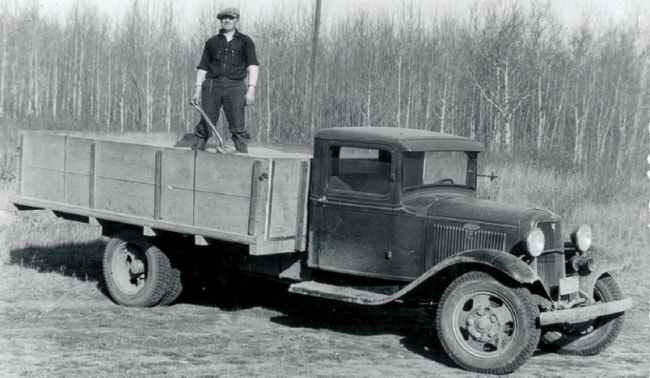Submitted
The following article and accompanying picture were submitted by the Sylvan Lake and District Archives Society as part of a series celebrating the society’s 20 years of existence this year. The Archives Society is open to the public every Tuesday and Thursday from noon to 4 p.m. at its new location in the lower level of the town’s Municipal Government Building.
When Charles Archambault built his General Store and opened the first Post Office at Sylvan Lake on May 1, 1907, the mail was picked up at Burnt Lake by Mr. Archambault, or by a helper on horseback or with a horse-drawn vehicle.
Five years later in February 1912, the CNWR train passed through the Village of Sylvan Lake, and from that time on there was no need for a horse – except to deliver mail to the Post Office, and that was soon solved with drays.
Drays delivered items to and from train stations and to businesses around town, and later, grain from farms to elevators. Both rail lines sported one or more grain elevators beside their tracks in town. The last one in use was demolished in 1998.
The Brown family bought a dray wagon (pictured) and set up a business in 1928. They soon saw a need for an ice business in town.
Using a buzz saw and a small horse-powered motor, they cut large blocks of ice from the lake in the winter and stored them in sawdust for the summer. Before the ice was delivered it had to be cut in smaller blocks with a crosscut saw, so that it would fit into the iceboxes of the people around town, as well as the cottage owners.
By the time the second World War began in 1939, their dray business had expanded to delivering fuel. Bill was one of the first to buy a truck and begin hauling grain, but he was a veteran in WWI, and when war was declared, he joined up immediately.
Later, Flo and her sons delivered coal as well.ÊWhen the boys also left to join the forces, the business was sold to Gordon Bigam and his father Andrew.
Another dray businesses was The Bergstrom Brothers Cartage during the 1920s. Carl, John and Nels Jr. owned large horses fitted with fancy harnesses, tassels and rings.
Drays were no longer needed when rail companies discontinued hauling freight by rail and began using trucks. This was just the beginning.
As roads improved, so did tires and motors, and trucks became specialized for the various loads. The introduction of refrigeration meant that perishable goods could be transported great distances, and ice deliveries were no longer needed.
If someone tells you they are in the ice making business today, it will no doubt be in a hockey or curling rink somewhere.
